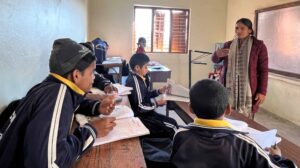
On International Day of Persons with Disabilities we celebrate, affirm, and promote the rights of people with disabilities – especially the right to receive an education.
Education builds the foundation for lifelong learning, growth, and opportunity. Through the LEARN – Leveraging Existing Accessibility Resources in Nepal – project, World Education and our partners aim to improve the language and literacy skills of early grade students with disabilities through the use of EdTech and Universal Design for Learning.
A recent report from the World Federation for the Deaf found that many teachers of deaf students had poor Nepali Sign Language skills themselves. To address this challenge, World Education collaborated with our partner, National Federation of the Deaf Nepal (NDFN), and government stakeholders to lead a ten-day training for teachers using Nepali Sign Language (NSL) in the classroom. The training and the LEARN project build on World Education’s work under the USAID-funded Reading for All project, which also seeks to improve learning outcomes for children with disabilities.
 The training refreshed and enhanced teachers’ skills so they can better instruct and support their students. One participant, Sudesh, an NSL Teacher in central Nepal said “I am a person with low vision and hearing impairments. I learned sign language in my school days, but I am still unable to sign all the words properly, which I knew after joining this training. Our NSL trainer provided us with various techniques to learn sign language for different words. This training is like a refresher for me to enhance my skills in sign language. As I teach deaf children in my school, I will teach correct sign language to the students using various techniques such as showing pictures on mobile devices or screens, showing real objects, and a step-by-step process to form a sign.”
The training refreshed and enhanced teachers’ skills so they can better instruct and support their students. One participant, Sudesh, an NSL Teacher in central Nepal said “I am a person with low vision and hearing impairments. I learned sign language in my school days, but I am still unable to sign all the words properly, which I knew after joining this training. Our NSL trainer provided us with various techniques to learn sign language for different words. This training is like a refresher for me to enhance my skills in sign language. As I teach deaf children in my school, I will teach correct sign language to the students using various techniques such as showing pictures on mobile devices or screens, showing real objects, and a step-by-step process to form a sign.”
Similarly, Manamaya, an NSL Teacher who teaches primary students at a special school for deaf children in Kathmandu, said “I never received NSL training before, and I learned sign language myself. It was very difficult for me to teach students by using sign language in the beginning. After receiving the 10 days of basic Nepali sign language training, I realized that many of the signs that I had learned for myself were mistakes, and I got an opportunity to correct myself in a good way. Along with that, our trainer taught us in a really effective way. Now I can use multiple methods to teach students. Also, using different mobile applications, showing videos and pictures on TV screens, and demonstrating with real objects, I can teach students in a more effective way.”
Investing in teacher professional development is key for high quality instruction that equips students with skills for their future, like digital literacy. The LEARN project is funded through the UnrestrICTed Challenge of All Children Reading: A Grand Challenge for Development (ACR GCD). ACR GCD is a partnership between USAID, World Vision and the Australian Government.




